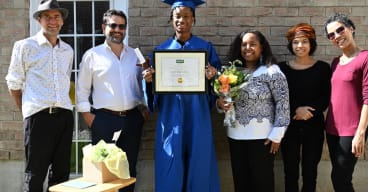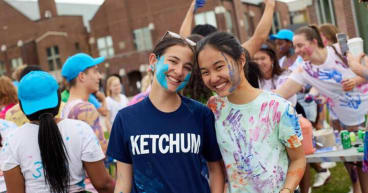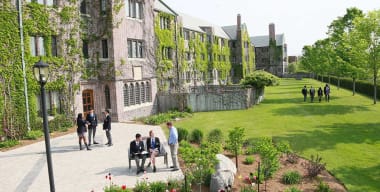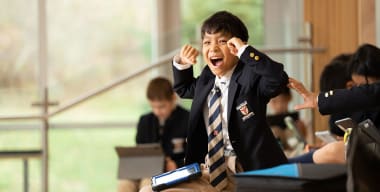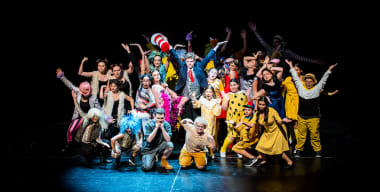Outward Bound Canada College is a small outdoor integrated program for Grade 11 and 12 students. Each semester, we admit up to 16 students into a program that teaches academic credits from the Ontario curriculum revolving around the themes of personal and Canadian identity and Environmental Literacy. Visual Art, History, English, Geography and Physical Education curricula are integrated through wilderness experience, expeditions and project- and inquiry-based learning.
During last year's winter semester, we wanted to take students on a creative journey, partly to get to know them on a less formal basis, but also to share some ways to unlock creativity in their academic and personal lives. What emerged was a weekend workshop spent at a solarpowered, wood-heated, rustic log cabin surrounded by 200 acres of forest, wetlands and lakes.
I wanted to give students some tools to get the creative juices flowing, move past creative blocks and delve into unexplored territory in their own writing and artwork. Within the bounds of curriculum expectations, educators tend to rush to the "meat": the rules, structures and prescribed methods associated with most disciplines. As educators, we sometimes fail to access the wellspring of ideas and imagination of our students; we fail to tap into the real source of education: the learner.
Priming the pump
We used a variety of ways to prime the pump of creativity: free writing, writing prompts and exercises, a bookmaking workshop, found-object sculpture making and physical and metaphorical rambles through the woods. We used the unique environment of the cabin, allowing students to move through natural spaces as well as social spaces. Escaping the four walls of the classroom was a great conduit for some focused creative work.
Movement is critical to spurring creativity and imagination, so we introduced timed freewriting exercises (where the pen does not leave the paper and the flow of writing continues free of editorial pauses) and artistic projects that involved wandering outdoors and choosing found objects at random for sculpture making.
Fuelling the fire
In an exercise called "Playing with Syntax," students free wrote for 10 minutes, then, like picking firewood off the forest floor, they circled every third word. With those words, they created a new passage. Reading both aloud to the group showed some fascinating and diverse results, and allowed students to see how a new voice, message or narrative pattern could come from simply selecting and rearranging words.
Powering up
Some students naturally gravitate toward expressive pursuits, generating essays and stories without apparent effort, filling entire note pages with doodles or handing in history assignments filled with illustrations. Other students have been labelled, or have labelled themselves, "non-creative"; they find writing painful and unfulfilling.
Rules and structure in writing and art, as in all academic subjects, are important; they lay the foundation for accurately expressing thoughts and feelings. But sometimes how we teach these rules and the emphasis we place on them creates blocks.
Over the weekend, we issued a "no-edit" rule, so students kept writing, painting, building and moving through their creative processes, regardless of what was coming out. As Julia Cameron, author of The Artist's Way and The Right to Write espouses, sometimes the best material and truest ideas lie under a pile of undigested, unexcavated mental detritus. The only way to get to it is to empty the container.
We allowed students to escape the rules in order to access imagination in its freest form. Then it was time to edit, choose and refine the veins of gold that emerged from the rubble.
Space to roam
Space for the mind and body to wander is critical to opening up the imagination. The number of students with attention deficit problems in the classroom today is a testament to the human need for movement. In his book The Last Child in the Woods, Richard Louv, who coined the phrase "Nature Deficit Disorder," cites the lack of freedom and exploration of wild spaces in children's lives as a major contributing factor to the increase in hyperactivity and focus issues in students.
Our "Getting Lost in the Woods (and Eventually Finding Yourself Again)" exercise experimented with this idea. The students took a solo walk, armed with sticks and flagging tape to mark their paths, a "turn-back time" and an assignment to wander within the property boundaries and notice the world around them. They were to bring back one item that they found on their walk, a token of their experience. Later, the objects served as a starting point for a piece of writing and a piece of sculpture.
The type of space you have for learning, studying or teaching can profoundly affect the outcome. At the cabin, everyone listened, shared, worked and created individually and collectively, and trust and relationships were cemented in the act of doing and being together.
Curriculum and Assessment
Curriculum expectations guided the workshop, rather than constraining it. Our students accepted the invitation to delve into the daunting territories of writing and art without some of the boundaries that can deter and stifle creative thought.
We created an environment free of assessment and judgment. What emerged was a plethora of raw and more refined imaginative materials that students could then choose to polish and hand in for assessment, or integrate into some of their other works-in-progress across the curriculum.
The combination of kinesthetic experiences, art, free writing and prompted writing practice, as well as preparing meals and living together, addressed a broad range of learning styles and inspired new ways of thinking, not just about writing and art, but about school and learning. Having "thrown the rubric out the window," students left the workshop realizing the value in accessing creativity and imagination in all aspects of their personal, work and school lives.

